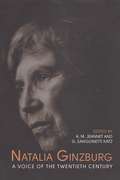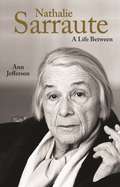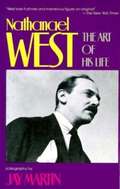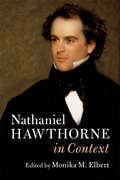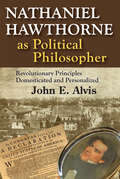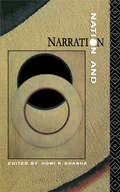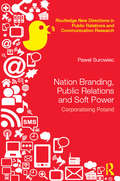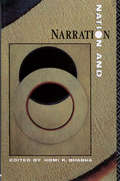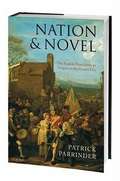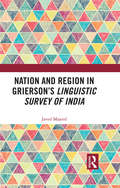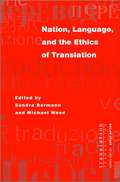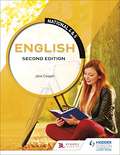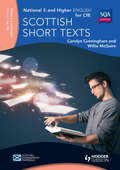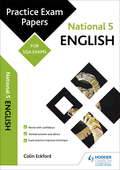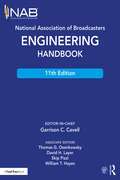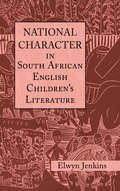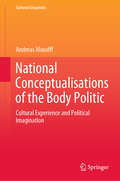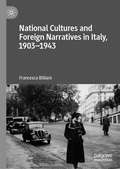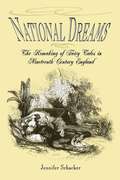- Table View
- List View
Natalia Ginzburg: A Voice of the Twentieth Century (The Royal Society of Canada Special Publications)
by Angela M. Jeannet Giuliana KatzA prominent and prolific Italian writer, Natalia Ginzburg (1916-1991) is known for her novels, plays, short stories, and essays. This collection brings together, for an English-speaking audience, a variety of critical perspectives on Ginzburg's work.The essays, all by North American scholars, examine the author's entire production. The topics examined include Ginzburg's struggle to define herself as a woman, a writer, and an intellectual; her interpretation of the relationship between historical events and private lives; her reflections on the women's movement and the changing nature of the family; and her mastery of a distinctly personal writing style. What emerges here is a nuanced and complex portrait of Ginzburg and her work. The reader is given a sense of the importance of her contribution, not only as a writer but as a witness to the events of the twentieth century. The volume also includes a chronology, a bibliography, and translations of some of Ginzburg's lesser-known writings, including three articles, a poem, and a one-act play.
Nathalie Sarraute: A Life Between
by Ann JeffersonThe definitive biography of a leading twentieth-century French writerA leading exponent of the nouveau roman, Nathalie Sarraute (1900–1999) was also one of France's most cosmopolitan literary figures, and her life was bound up with the intellectual and political ferment of twentieth-century Europe. Ann Jefferson's Nathalie Sarraute: A Life Between is the authoritative biography of this major writer.Sarraute's life spanned a century and a continent. Born in tsarist Russia to Jewish parents, she was soon uprooted and brought to the city that became her lifelong home, Paris. This dislocation presaged a life marked by ambiguity and ambivalence. A stepchild in two families, a Russian émigré in Paris, a Jew in bourgeois French society, and a woman in a man’s literary world, Sarraute was educated at Oxford, Berlin, and the Sorbonne. She embarked on a career in law that was ended by the Nazi occupation of France, and she spent much of the war in hiding, under constant threat of exposure. Rising to literary eminence after the Liberation, she was initially associated with the existentialist circle of Beauvoir and Sartre, before becoming the principal theorist and practitioner of the avant-garde French novel of the 1950s and 1960s. Her tireless exploration of the deepest parts of our inner psychological life produced an oeuvre that remains daringly modern and resolutely unclassifiable.Nathalie Sarraute: A Life Between explores Sarraute's work and the intellectual, social, and political context from which it emerged. Drawing on newly available archival material and Sarraute's letters, this deeply researched biography is the definitive account of a life lived between countries, families, languages, literary movements, and more.
Nathanael West: The Art of His Life
by Jay MartinNathanael West was one of America's most original writers. His novels, especially The Day of the Locust and Miss Lonelyhearts, continue to be widely read and stand as a particularly American image of tragedy drawn from popular and democratic culture. The story of his life is as poignant and terrifying as anything in his novels. Jay Martin has written a biography that has bee praised as the last word on a mythic life. Martin successfully traces that certain inspiration, hard-going development, and inevitable demise of West's vision.
Nathaniel Hawthorne
by George E. WoodberryOne of a series (American Writers Series) of the Gale Library of Lives and Letters.
Nathaniel Hawthorne In Context (Literature in Context)
by Monika M. ElbertThis volume provides a comprehensive overview of Nathaniel Hawthorne and demonstrates why he continues to be a critically significant figure in American literature. The first section focuses on Hawthorne's interest in and knowledge of past (Puritan and colonial) and contemporary nineteenth-century history (women's, African American, Native American) as the inspiration for his writings and the source of his literary success. The second section explores his fascination with social history and popular culture by examining topics as mesmerism, utopian life styles, theatrical performances, and artistic innovations. The third section looks at how Hawthorne succeeded and excelled in the literary marketplace, as an author of children's literature, literary sketches, and historical romances. In the fourth section, Hawthorne's literary precursors, peers, colleagues, and successors are analyzed. In the final section, Hawthorne's attachment to family, nature, and home is examined as the source of creative inspiration and philosophical questing.
Nathaniel Hawthorne In His Times
by James R. MellowCarefully documented biography and literary analysis.
Nathaniel Hawthorne as Political Philosopher: Revolutionary Principles Domesticated and Personalized
by John E. AlvisUsing the works of Nathaniel Hawthorne as a case study, John E. Alvis shows that a novelist can be a political philosopher. He demonstrates that much of Hawthorne's works are rooted in the American political tradition. Once we view his writings in connection with the principles expressed in the Declaration of Independence, we grasp that what Thomas Jefferson and John Adams had stated explicitly, Hawthorne's fiction conveys dramatically. With examples drawn from Hawthorne's shorter works, as well as acknowledged classics, such as The Scarlet Letter, John E. Alvis shows that Hawthorne's characters bear something sacred in their generic humanity, yet are subject to moral judgment. He conveys reciprocity between obligations regulating individual relations and the responsibilities of individuals to their community.From America's founding proclamations in the Declaration of Independence we take a sense of national aspirations for a political order that conforms to laws of nature and nature's God. From this higher law emerge the principles enumerated in that revolutionary document. Are these principles confined to the political, or do they reach into the experience of citizens to inform conduct? Do they include family, local community, and individual face-to-face relations with neighbors and strangers? Can one make a distinct way of life by fidelity to such standards as higher law, equality, liberty, natural rights, and consent?This study is distinguished from other writings on Hawthorne in its largely positive focus on America. Alvis characterizes Hawthorne as a rational patriot who endorses America's new terms for human association. This fascinating study provides new insights into the mind of one of the greatest American writers.
Nathaniel Hawthorne: A Biography
by Randall StewartA careful presentation of the life with some emphasis on how this conditioned his literature.
Nation & Narration
by Homi K BhabhaBhabha, in his preface, writes 'Nations, like narratives, lose their origins in the myths of time and only fully encounter their horizons in the mind's eye'. From this seemingly impossibly metaphorical beginning, this volume confronts the realities of the concept of nationhood as it is lived and the profound ambivalence of language as it is written. From Gillian Beer's reading of Virginia Woolf, Rachel Bowlby's cultural history of Uncle Tom's Cabin and Francis Mulhern's study of Leaviste's 'English ethics'; to Doris Sommer's study of the 'magical realism' of Latin American fiction and Sneja Gunew's analysis of Australian writing, Nation and Narration is a celebration of the fact that English is no longer an English national consciousness, which is not nationalist, but is the only thing that will give us an international dimension.
Nation Branding, Public Relations and Soft Power: Corporatising Poland (Routledge New Directions in PR & Communication Research)
by Pawel SurowiecNation Branding, Public Relations and Soft Power: Corporatizing Poland provides an empirically grounded analysis of changes in the way in which various actors seek to manage Poland’s national image in world opinion. It explores how and why changes in political economy have shaped these actors and their use of soft power in a way that is influenced by public relations, corporate communication, and marketing practices. <P><P>By examining the discourse and practices of professional nation branders who have re-shaped the relationship between collective identities and national image management, it plots changes in the way in which Poland’s national image is communicated, and culturally reshaped, creating tensions between national identity and democracy. The book demonstrates that nation branding is a consequence of the corporatization of political governance, soft power and national identity, while revealing how the Poland "brand" is shaping public and foreign affairs. <P><P>Challenging and original, this book will be of interest to scholars in public relations, corporate communications, political marketing and international relations.
Nation and Citizenship in the Twentieth-Century British Novel
by Janice HoNation and Citizenship in the Twentieth-Century British Novel charts how novelists imagined changing forms of citizenship in twentieth-century Britain. This study offers a new way of understanding the constitution of the nation-state in terms of the concept of citizenship. Through close readings, it reveals how major authors such as E. M. Forster, Virginia Woolf, Elizabeth Bowen, Sam Selvon, Buchi Emecheta, Salman Rushdie, and Monica Ali presented political struggles over citizenship during key historical moments: the advent of democracy, the emancipation of women, the rise of social-welfare provision, the institution of the security state during World War II, and the emergence of multicultural citizenship during postwar immigration. This serves as the first full-length monograph to map the interrelations between literary production and public debates about citizenship that shaped Britain in the twentieth century.
Nation and Narration
by Homi K. BhabhaBhabha, in his preface, writes 'Nations, like narratives, lose their origins in the myths of time and only fully encounter their horizons in the mind's eye'.From this seemingly impossibly metaphorical beginning, this volume confronts the realities of the concept of nationhood as it is lived and the profound ambivalence of language as it is written. From Gillian Beer's reading of Virginia Woolf, Rachel Bowlby's cultural history of Uncle Tom's Cabin and Francis Mulhern's study of Leaviste's 'English ethics'; to Doris Sommer's study of the 'magical realism' of Latin American fiction and Sneja Gunew's analysis of Australian writing, Nation and Narration is a celebration of the fact that English is no longer an English national consciousness, which is not nationalist, but is the only thing that will give us an international dimension.
Nation and Novel: The English Novel From Its Origins To The Present Day
by Patrick ParrinderWhat is "English" about the English novel, and how has the idea of the English nation been shaped by the writers of fiction? How do the novel's profound differences from poetry and drama affect its representation of national consciousness? Nation and Novel sets out to answer these questions by tracing English prose fiction from its late medieval origins through its stories of rogues and criminals, family rebellions and suffering heroines, to the present-day novels of immigration. Major novelists from Daniel Defoe to the late twentieth century have drawn on national history and mythology in novels which have pitted Cavalier against Puritan, Tory against Whig, region against nation, and domesticity against empire. The novel is deeply concerned with the fate of the nation, but almost always at variance with official and ruling-class perspectives on English society. Patrick Parrinder's groundbreaking new literary history outlines the English novel's distinctive, sometimes paradoxical, and often subversive view of national character and identity. This sophisticated yet accessible assessment of the relationship between fiction and nation will set the agenda for future research and debate.
Nation and Region in Grierson’s Linguistic Survey of India
by Javed MajeedGeorge Abraham Grierson’s Linguistic Survey of India is one of the most complete sources on South Asian languages. This book is the first detailed examination of the Survey. It shows how the Survey collaborated with Indian activists to consolidate the regional languages in India. By focusing on India as a linguistic region, it was at odds with the colonial state’s conceptualisation of the subcontinent, in which religious and caste differences were key to its understanding of Indian society. A number of the Survey’s narratives are detachable from its rigorous linguistic imperatives, and together with aspects of Grierson’s other texts, these contributed to the way in which Indian nationalists appropriated and reshaped languages, making them religiously charged ideological symbols of particular versions of the subcontinent. Thus, the Survey played an important role in the emergence of religious nationalism and language conflict in the subcontinent in the 20th century. This volume, like its companion volume Colonialism and Knowledge in Grierson’s Linguistic Survey of India, will be a great resource for scholars and researchers of linguistics, language and literature, history, political studies, cultural studies and South Asian studies.
Nation, Language, and the Ethics of Translation (Translation/Transnation #10)
by Sandra Bermann and Michael WoodIn recent years, scholarship on translation has moved well beyond the technicalities of converting one language into another and beyond conventional translation theory. With new technologies blurring distinctions between "the original" and its reproductions, and with globalization redefining national and cultural boundaries, "translation" is now emerging as a reformulated subject of lively, interdisciplinary debate. Nation, Language, and the Ethics of Translation enters the heart of this debate. It covers an exceptional range of topics, from simultaneous translation to legal theory, from the language of exile to the language of new nations, from the press to the cinema; and cultures and languages from contemporary Bengal to ancient Japan, from translations of Homer to the work of Don DeLillo. All twenty-two essays, by leading voices including Gayatri Spivak and the late Edward Said, are provocative and persuasive. The book's four sections--"Translation as Medium and across Media," "The Ethics of Translation," "Translation and Difference," and "Beyond the Nation"--together provide a comprehensive view of current thinking on nationality and translation, one that will be widely consulted for years to come. The contributors are Jonathan E. Abel, Emily Apter, Sandra Bermann, Vilashini Cooppan, Stanley Corngold, David Damrosch, Robert Eaglestone, Stathis Gourgouris, Pierre Legrand, Jacques Lezra, Françoise Lionnet, Sylvia Molloy, Yopie Prins, Edward Said, Azade Seyhan, Gayatri Chakravorty Spivak, Henry Staten, Lawrence Venuti, Lynn Visson, Gauri Viswanathan, Samuel Weber, and Michael Wood.
National 4 & 5 English, Second Edition
by Jane CooperExam Board: SQALevel: National 5Subject: EnglishFirst teaching: August 2017First exams: Summer 2018Introduce, develop, test and reinforce the skills required for success in National 4 & 5 English.Fully updated in accordance with the revised N5 specification, this Second Edition covers both the N4 and N5 assessments.> Gradually develops students' skills and knowledge across the four keys areas of English: reading, writing, listening and talking> Engages students through regular active learning tasks, which also enable you and your students to check their understanding> Thoroughly prepares students for the N5 exam, with Practice Exercises, answers and mark schemes> Contains new material for RUAE and the spoken language assessment, plus a new section with revision tips> Enables you to teach N4 and N5 simultaneously or separately by providing a practical and flexible pathway through the syllabus
National 4 & 5 English: Second Edition Epub
by Jane CooperThis new edition of the National 4 & 5 English textbook is fully up to date for National 4 and 5 courses, including the latest updates to National 5. It recognises the removal of Purpose and Audience from both courses, and includes new material for Reading for Understanding, Analysis, and Evaluation at National 5, and for the National 5 Spoken Language Assessment.Throughout the book, the necessary skills or areas of knowledge are introduced gradually, tested with brief activities, demonstrated again, and then reinforced with end-of-chapter activities and questions that mirror SQA examination papers.Ensure your students are prepared for every aspect of their assessment with fully comprehensive coverage of the new syllabus requirements:- updated to support the new course specification and address all skills covered in the SQA examinations- reflects changes in the set text list- provides thorough exam preparation, with Practice Exercises, and associated answers and mark schemes- includes a new focused revision tips section- written by a highly experienced and respected author- provides an engaging and practical pathway through the syllabus- organised to make it easy to plan, manage and monitor student progress.
National 5 & Higher English: Scottish Short Texts
by Willie Mcguire Carolyn CunninghamThis title is endorsed by SQA.Shows students how they can enhance their writing skills and improve their National 5 grade, by detailing the basic Portfolio requirements and illustrating different writing forms that may be used.Writing skills in the Folio submission make up 30% of the marks in National 5 English, and this book has been written to show students how they can enhance those writing skills and improve their National 5 grade at the same time! As well as detailing the basic Folio requirements, the book explains and illustrates different writing forms that may be used, the 'writing process' and assessment criteria. Common errors - and how to avoid them - are illustrated, and suggested answers are also provided to typical tasks.- A completely authoritative one-volume guide to the Folio writing process, which makes up 30% of a candidate's grade at National 5- Written by a highly experienced examiner and setter- Provides practical, down-to-earth guidance for students about the 'writing process'
National 5 English: Practice Papers for SQA Exams
by Colin EckfordPractise for your SQA exams with three specially-commissioned Hodder Gibson Practice Exam Papers.- Practise with model papers written and checked by experienced markers and examiners- Get extra advice with specially-written study-skills guidance sections- Gain vital extra marks and avoid common mistakes with examiner tips
National Association of Broadcasters Engineering Handbook
by Garrison C. CavellThe NAB Engineering Handbook is the definitive resource for broadcast engineers. It provides in-depth information about each aspect of the broadcast chain from audio and video contribution through an entire broadcast facility all the way to the antenna. New topics include Ultra High Definition Television, Internet Radio Interfacing and Streaming, ATSC 3.0, Digital Audio Compression Techniques, Digital Television Audio Loudness Management, and Video Format and Standards Conversion. Important updates have been made to incumbent topics such as AM, Shortwave, FM and Television Transmitting Systems, Studio Lighting, Cameras, and Principles of Acoustics. The big-picture, comprehensive nature of the NAB Engineering Handbook will appeal to all broadcast engineers—everyone from broadcast chief engineers, who need expanded knowledge of all the specialized areas they encounter in the field, to technologists in specialized fields like IT and RF who are interested in learning about unfamiliar topics. Chapters are written to be accessible and easy to understand by all levels of engineers and technicians. A wide range of related topics that engineers and technical managers need to understand are covered, including broadcast documentation, FCC practices, technical standards, security, safety, disaster planning, facility planning, project management, and engineering management.
National Character in South African English Children's Literature (Children's Literature and Culture #41)
by Elwyn JenkinsThis is the first full-length study of South African English youth literature to cover the entire period of its publication, from the late nineteenth century to the early twenty-first century. Jenkins' book focuses on what made the subsequent literature essentially South African and what aspects of the country and its society authors concentrated on. What gives this book particular strength is its coverage of literature up to the 1960s, which has until now received almost no scholarly attention. Not only is this earlier literature a rewarding subject for study in itself, but it also throws light on subsequent literary developments. Another exceptional feature is that the book follows the author’s previous work in placing children’s literature in the context of adult South African literature and South African cultural history (e.g. cinema). He also makes enlightening comparisons with American, Canadian and Australian children’s literature.
National Conceptualisations of the Body Politic: Cultural Experience and Political Imagination (Cultural Linguistics)
by Andreas MusolffThis book presents the results of a large-scale experiment into interpretations of the metaphor “the Nation as a Body” among 1,800+ respondents from 30 linguistic and cultural backgrounds. In this first account of an empirical study of cross-cultural global metaphor interpretation of that scale, Musolff confirms that the meanings of metaphors are complex, culturally mediated and may differ for senders and recipients. The book provides a historical and cultural map of the traditions underlying differences in how the nation as a body – or, “the body politic” – is understood. Musolff challenges the hypotheses of the universality of “the nation” as a predominantly male-gendered and hierarchically organized concept and, in so doing, puts into question some of the key presuppositions of traditional historical and cognitive approaches to metaphor. For scholars and students of figurative language, the book lays out methodological foundations for cross-cultural metaphor comparison and reveals hidden meaning differences in political metaphor in English as lingua franca.
National Cultures and Foreign Narratives in Italy, 1903–1943
by Francesca BillianiNational Cultures and Foreign Narratives charts the pathways through which foreign literature in translation has arrived in Italy during the first half of the twentieth century. To show the contribution translations made to shaping an Italian national culture, it draws on a wealth of archival material made available in English for the first time.
National Dreams: The Remaking of Fairy Tales in Nineteenth-Century England
by Jennifer SchackerFairy tales and folktales have long been mainstays of children's literature, celebrated as imaginatively liberating, psychologically therapeutic, and mirrors of foreign culture. Focusing on the fairy tale in nineteenth-century England, where many collections found their largest readership, National Dreams examines influential but critically neglected early experiments in the presentation of international tale traditions to English readers. Jennifer Schacker looks at such wondrous story collections as Grimms' fairy tales and The Arabian Nights in order to trace the larger stories of cross-cultural encounter in which these books were originally embedded. Examining aspects of publishing history alongside her critical readings of tale collections' introductions, annotations, story texts, and illustrations, Schacker's National Dreams reveals the surprising ways fairy tales shaped and were shaped by their readers.Schacker shows how the folklore of foreign lands became popular reading material for a broad English audience, historicizing assumed connections between traditional narrative and children's reading. The tales imported and presented by such British writers as Edgar Taylor, T. Crofton Croker, Edward Lane, and George Webbe Dasent were intended to stimulate readers' imaginations in more ways than one. Fairy-tale collections provided flights of fancy but also opportunities for reflection on the modern self, on the transformation of popular culture, and on the nature of "Englishness." Schacker demonstrates that such critical reflections were not incidental to the popularity of foreign tales but central to their magical hold on the English imagination.Offering a theoretically sophisticated perspective on the origins of current assumptions about the significance of fairy tales, National Dreams provides a rare look at the nature and emergence of one of the most powerful and enduring genres in English literature.
